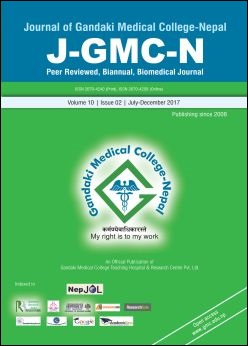Loop-Mediated Isothermal Amplification Assay for Rapid and Reliable Detection of Mycobacterium tuberculosis in Sputum Samples
DOI:
https://doi.org/10.3126/jgmcn.v10i2.20805Keywords:
Culture, Loop-Mediated Isothermal Amplification, Microscopy, Mycobacterium tuberculosis, Polymerase Chain ReactionAbstract
Introduction: Tuberculosis (TB) remains a major global health problem. The most common method for diagnosing TB in developing countries is sputum smear microscopy; however, the sensitivity of this test is relatively lower. Detection of Mycobacterium tuberculosis using conventional culture and biochemical-based assays is time-consuming and laborious. Polymerase Chain Reaction (PCR) is also available for diagnosis of Mycobacterium tuberculosis. However, the PCR assay requires an expensive thermal cycler to amplify the DNA fragment in multiple temperature-dependent steps. Therefore, a simple and sensitive method for rapid detection has been anxiously awaited. The loop-mediated isothermal amplification (LAMP) assay is a diagnostic technique which can aid in the fight against TB in resource-poor countries. The LAMP assay can amplify a targeted sequence at a constant temperature. Therefore, a large and costly thermal cycler is not necessary for a LAMP assay.
Objectives: The objective of this study was to identify Mycobacterium tuberculosis directly from sputum by LAMP and to compare its efficacy over routinely used methods.
Methods: A total of 106 (53 fluorochrome staining positive and 53 fluorochrome staining negative) sputum samples were collected in this study. Mycobacterial DNA was extracted from concentrated sputum samples by freezing and boiling method. LAMP assay using a set of six specific primers targeting the M. tuberculosis 16S rRNA gene with high sensitivity was used to analyze sputum samples. The results were then compared with that of the culture method, which was considered as the gold standard method.
Results: Among total of 106 samples studied by microscopy and culture, 53 were positive by both, whole four were positive by culture but negative by microscopy. With reference to culture, the microscopy had sensitivity 92.98%, specificity 100%, and predictive value of positive test 100%, predictive value of negative test 92.5%. Out of 106 samples subjected to culture and LAMP for the diagnosis of TB, 55 samples were positive by both tests and two were positive only in culture, while 48 were negative in both tests and one was negative only in culture. While comparing the LAMP with culture as a gold standard, the sensitivity of LAMP was 96.49%, specificity was 97.95%, predictive value of positive test was 98.21%, predictive value of negative test was 96%.
Conclusions: Comparative experiments showed that the LAMP assay is a rapid, sensitive, and specific method to detect M. tuberculosis infection. Indeed, an inexpensive LAMP assay would be potential as a diagnostic test for tuberculosis, especially in resource-limited settings.
J-GMC-N | Volume 11 | Issue 01 | January-June 2018, Page: 27-34
Downloads
Downloads
Published
How to Cite
Issue
Section
License
This license allows reusers to distribute, remix, adapt, and build upon the material in any medium or format for noncommercial purposes only, and only so long as attribution is given to the creator.

